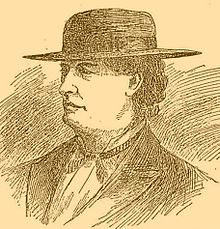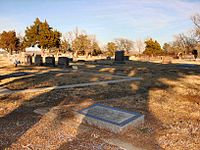Temple Lea Houston
Temple Lea Houston | |
|---|---|
 Chicago Tribune, June 21, 1896 | |
| Texas State Senator from District 19 (based in Mobeetie in Wheeler County) | |
| In office 1885–1889 | |
| Preceded by | Avery Matlock |
| Succeeded by | John Hall Stephens |
| Personal details | |
| Born | August 12, 1860 Austin, Travis County Texas, USA |
| Died | August 15, 1905 (aged 45) Woodward, Oklahoma |
| Resting place | Elmwood Cemetery in Woodward, Oklahoma |
| Nationality | USA |
| Political party | Democratic |
| Spouse | Laura Cross Houston |
| Alma mater | Baylor University |
| Occupation | Lawyer |
Temple Lea Houston (August 12, 1860 – August 15, 1905) was an attorney and politician who served from 1885 to 1889 in the Texas State Senate. He was the last-born child of Margaret Lea Houston and Sam Houston, the first elected president of the Republic of Texas.[a]
Biography

Temple Lea Houston was the only one of the Houstons' eight children to be born in the Texas governor's residence in Austin. By the time he was seven, both his parents had died. He lived with an older sister and her family in nearby Georgetown, Texas. At the age of thirteen, Houston left home to join a cattle drive and later worked on a riverboat on the Mississippi River. Aided by a friend of his father's, he gained an appointment as a page in the U.S. Senate and worked in Washington, D.C. for three years.
Houston returned to Texas in 1877 at the age of seventeen to attend the Agricultural and Mechanical College (now Texas A&M University). He transferred to Baylor University in Waco, Texas, where he graduated in 1880 with honors in law and philosophy. He "read the law" with an established firm and was admitted to the bar. He was the youngest attorney in Texas when he opened his practice.[3] That year he was appointed as the attorney for Brazoria County near Houston, Texas.[3]
In 1882, Houston was appointed as the district attorney of the 35th Judicial District of Texas, which then covered a large part of the Texas Panhandle, based in Mobeetie, Wheeler County.
Marriage and family
Established in his career, on February 14, 1883, Houston at the age of twenty-three married Laura Cross, the daughter of a planter. They lived near Fort Elliott, which protected the border against American Indians, as well as the important cattle drives. The couple had seven children, only four of whom lived past infancy.[3]
Political career

Houston was elected in 1884 to a single term in the Texas State Senate from District 19.
He concentrated his law practice on the Santa Fe railroad (the Atchison, Topeka and Santa Fe Railway).[3] He spoke French and Spanish, as well as seven Indian languages. In 1888, he gave the dedication address for the opening of the Texas State Capitol, which is still in use after several renovations.[4]
In 1894, Houston moved his family to the cattle town of Woodward in Oklahoma Territory. He was legal counsel of the Atchison, Topeka and Santa Fe Railway; its Woodward depot became one of the most important points in the territory for cattle shipping to the East. Houston became widely known and popular for his courtroom dramatics. He was charged with murder in the shooting of a brother of the outlaw Al Jennings, after an argument in the Cabinet Saloon, and was acquitted.
Houston won a reputation as a brilliant trial lawyer. In 1899, he delivered his "Soiled Dove Plea" in a makeshift courtroom in Woodward's opera house. The argument on behalf of Minnie Stacey, a prostitute who worked at the Dew Drop Inn, became famous for winning her acquittal after ten minutes' consideration by the jury.[3]
An historian, William T. Hagan, described Houston as "a flamboyant figure in his black frock coat and shoulder-length auburn hair topped off with a white Stetson. He liked to lace his arguments with literary allusions and could enthrall a courtroom or legislative chamber."[5][6]
Death

Temple Lea Houston died on August 15, 1905. His wife Laura (Cross) Houston died April 17, 1938. They are buried together at Elmwood Cemetery in Woodward, Oklahoma.
Representation in other media
- Edna Ferber modeled her main character of Yancey Cravat on Temple Houston in her novel Cimarron (1929). (The novel was adapted as film versions under the same name, produced in 1931 and 1960.)
- Ross Elliott played Houston in "The Reluctant Gun" (1959) episode of the western anthology series, Death Valley Days.[7]
- In the 1960 film Oklahoma Territory, Houston was played by Bill Williams. Gloria Talbott was cast as Ruth Red Hawk, Ted de Corsia as Chief Buffalo Horn, X Brands as Running Cloud, and Walter Sande as Marshal Pete Rosslyn. The film was written by Orville H. Hampton and directed by Edward L. Cahn.
- A 1963–1964 NBC/Warner Brothers television series entitled Temple Houston, which aired twenty-six episodes, was co-produced by the actor Jeffrey Hunter, who also played the part of Houston. Temple Houston was placed on the schedule in a matter of six weeks after it was sold by studio boss Jack Webb to the network.[6][8]
Houston family tree
|
Notes
References
Bibliography
|
Footnotes
- ^ David G. Burnet was the first president of the Republic of Texas, serving on an interim basis March 18 – October 22, 1836, while Sam Houston led the army against the Mexican forces.[1] After Houston's capture of Santa Anna, elections were held in the Republic and he became the first elected president of the Republic and later the third president. After Texas was annexed by the United States, Sam Houston became a United States senator from Texas, and was later elected as the state's seventh governor.[2]
References
- ^ "A Guide to the David Gouverneur Burnet Papers, 1798–1965". Briscoe Center for American History. Retrieved 6 August 2014.
- ^ Kreneck, Thomas H. "Sam Houston". Handbook of Texas Online. Texas State Historical Association. Retrieved 6 August 2014.
- ^ a b c d e Anderson, H. Allen. "Temple Lea Houston". Handbook of Texas Online. Texas State Historical Association. Retrieved 2 March 2012.
- ^ Texas Capitol Building Dedication, Texas Bob website
- ^ William T. Hagan, Charles Goodnight: Father of the Texas Panhandle (Norman: University of Oklahoma Press, 2007) , pp. 89–90
- ^ a b Billy Hathorn, "Roy Bean, Temple Houston, Bill Longley, Ranald Mackenzie, Buffalo Bill, Jr., and the Texas Rangers: Depictions of West Texans in Series Television, 1955 to 1967", West Texas Historical Review, Vol. 89 (2013), pp. 106–109
- ^ ""The Reluctant Gun", Death Valley Days, December 26, 1959". Internet Movie Data Base. Retrieved May 8, 2014.
- ^ "Temple Houston: The Story Behind a Forgotten Television Western", Wildest Westerns website
Further reading
- Grace Hunter Adams, Jack Love: Eighty Niner, Traditional, 1988.
- James D. Hamlin, The Flamboyant Judge: As Told to J. Evetts Haley and William Curry Holden' (Canyon, Texas: Palo Duro, 1972).
- Sallie B. Harris, Cowmen and Ladies: A History of Hemphill County (Canyon, Texas: Staked Plains, 1977).
- Louise B. James, Below Devil's Gap: The Story of Woodward County, Perkins, Okla.: Evans Publications, 1984
- Seale, William (1992) [1970]. Sam Houston's Wife: A Biography of Margaret Lea Houston. University of Oklahoma Press. ISBN 978-0-8061-2436-0.
- Glenn Shirley, Temple Houston: Lawyer with a Gun (Norman: University of Oklahoma Press, 1980).
- Bernice Tune, Golden Heritage and Silver Tongue of Temple Lea Houston (Burnet, Texas: Eakin Press, 1981).
External links
- Houston Family Papers, 1836–1969 and undated, in the Southwest Collection/Special Collections Library, Texas Tech University
- Beth Ann Doughty, "Houston, Temple", Encyclopedia of Oklahoma History and Culture
- Temple Lea Houston at Find a Grave
